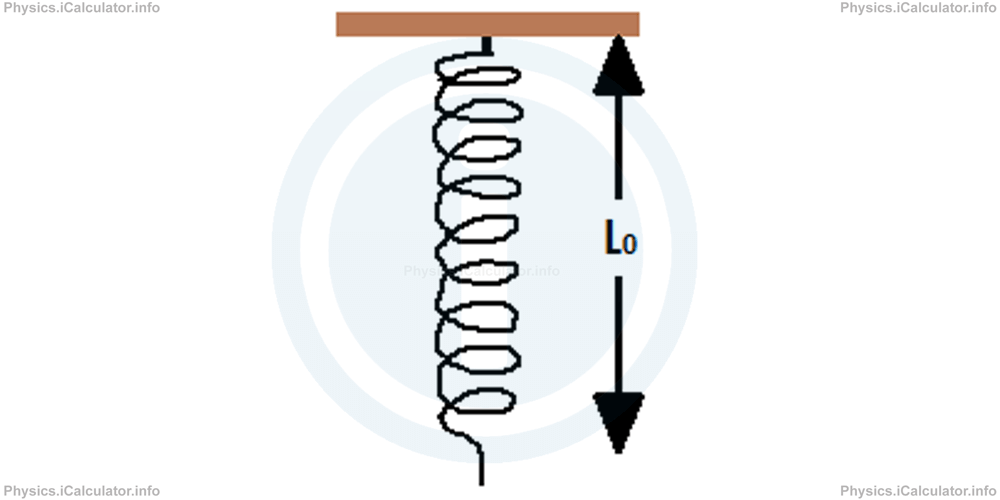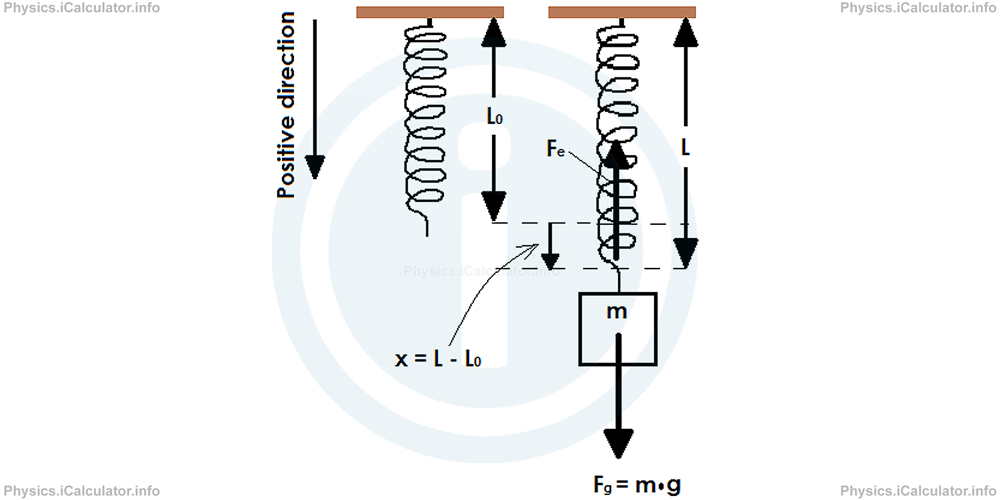Menu
Physics Lesson 4.4.2 - Elastic Force and the Factors Affecting It
Please provide a rating, it takes seconds and helps us to keep this resource free for all to use
Welcome to our Physics lesson on Elastic Force and the Factors Affecting It, this is the second lesson of our suite of physics lessons covering the topic of Types of Forces III (Elastic Force and Tension), you can find links to the other lessons within this tutorial and access additional physics learning resources below this lesson.
Elastic Force and the Factors Affecting It
Suppose you have a perfectly elastic spring hanged in the vertical position as shown in the figure. 
The original (unstretched) length of the spring is denoted by L0. If we hook an object of mass m on it, as shown in the figure below, the final length of the stretched spring becomes L.
We denote by x⃗ the difference between the actual position L and the original position L0 of the spring. It represents the linear deformation of the spring. Therefore, we have
Look at the figure below.

Figure 2. An elastic spring before and after hanging an object on it
Even during the compression, we use the same reasoning as well. The only difference is that in compression, the linear deformation x⃗ is negative because L < L0. Therefore, we say the linear deformation x⃗ is a vector quantity as it involves direction.
Since the object m is in equilibrium, it is clear that there are two equal and opposite forces acting on it. One is the gravitational force which acts downwards as it tries to send the object on the Earth surface, while the other is the resistive force of the spring which acts upwards as the spring tries to resist to any deformation caused by external factors (such as the hanged object in the specific case). This resistive force is known as Elastic (or Restoring) Force, Fe⃗ as it tries to restore the spring's original length (look at again the figure above).
Since there is equilibrium, the resultant force acting on the object m is zero. Therefore, we have
or
The restoring force, also known as the Elastic Force is in the opposite direction to the deformation x⃗. Its equation is
Equation 1 (Hooke's Law)
F⃗e = -k × x⃗where k is a constant known as "coefficient of elasticity" or "spring constant" which depends on the properties of material, thickness of spring etc. We can determine the unit of k by rearranging the formula (1). Thus, we have
The equation (1) is known as the "Hooke's Law."
Example 1
A 300 g object is hanged on a spring as in the figure (2). As a result, the spring stretches by 12 cm. What is the magnitude of the spring constant expressed to the nearest whole number? Take g⃗ = 9.81 m/s2.
Solution 1
First, we convert the units into the SI ones. Thus, m = 300 g = 0.300kg and x⃗ = 12cm = 0.12m.
Since there is equilibrium, we have
where F⃗g = m × g⃗ and F⃗e = -k × x⃗.
Thus, substituting the known formulae of gravitational and elastic force, we obtain
m × g⃗ = k × x⃗
k = m × g⃗/x⃗
= 0.300 × 9.81/0.12
= 24.525 N/m
≈ 25 N/m
You have reached the end of Physics lesson 4.4.2 Elastic Force and the Factors Affecting It. There are 4 lessons in this physics tutorial covering Types of Forces III (Elastic Force and Tension), you can access all the lessons from this tutorial below.
More Types of Forces III (Elastic Force and Tension) Lessons and Learning Resources
Whats next?
Enjoy the "Elastic Force and the Factors Affecting It" physics lesson? People who liked the "Types of Forces III (Elastic Force and Tension) lesson found the following resources useful:
- Factors Feedback. Helps other - Leave a rating for this factors (see below)
- Dynamics Physics tutorial: Types of Forces III (Elastic Force and Tension). Read the Types of Forces III (Elastic Force and Tension) physics tutorial and build your physics knowledge of Dynamics
- Dynamics Revision Notes: Types of Forces III (Elastic Force and Tension). Print the notes so you can revise the key points covered in the physics tutorial for Types of Forces III (Elastic Force and Tension)
- Dynamics Practice Questions: Types of Forces III (Elastic Force and Tension). Test and improve your knowledge of Types of Forces III (Elastic Force and Tension) with example questins and answers
- Check your calculations for Dynamics questions with our excellent Dynamics calculators which contain full equations and calculations clearly displayed line by line. See the Dynamics Calculators by iCalculator™ below.
- Continuing learning dynamics - read our next physics tutorial: Newton's First Law of Motion. The Meaning of Inertia
Help others Learning Physics just like you
Please provide a rating, it takes seconds and helps us to keep this resource free for all to use
We hope you found this Physics lesson "Types of Forces III (Elastic Force and Tension)" useful. If you did it would be great if you could spare the time to rate this physics lesson (simply click on the number of stars that match your assessment of this physics learning aide) and/or share on social media, this helps us identify popular tutorials and calculators and expand our free learning resources to support our users around the world have free access to expand their knowledge of physics and other disciplines.